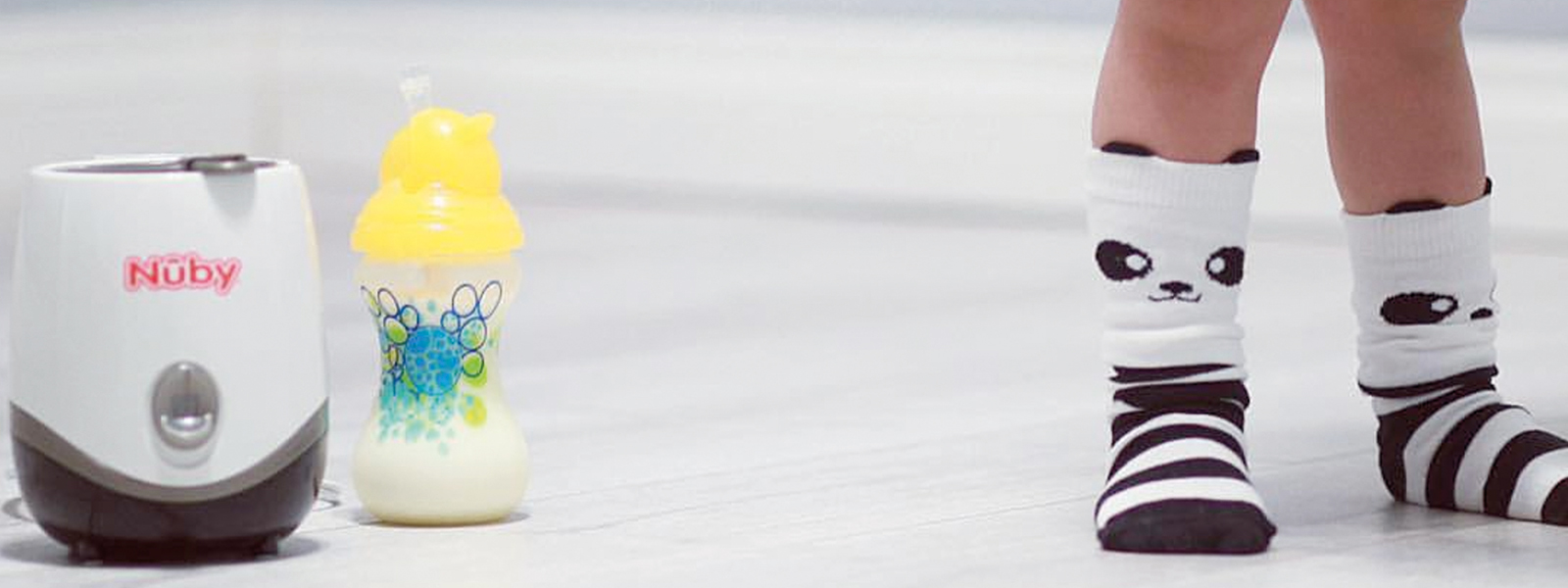As a new parent, obviously, you want to protect your baby from as many filthy bacteria as possible. Sterilising the bottles and pacifiers that end up in their mouth every day is an important part of that. But what is the best way of cleaning exactly?
 |
Recommendations for sterilising
There are different recommendations to be found when it comes to whether or not you should sterilise drinking bottles and pacifiers and how often you should do that. According to some, just a thorough wash with mild soap is sufficient, because the materials of bottles and pacifiers these days have been improved significantly. Others insist that sterilising (regularly) is still recommended. There’s no doubt that sterilising kills bacteria and is definitely the safest way of cleaning your baby products. But, you should take into consideration that the bottles and pacifiers have to be suited for sterilising at high temperatures. When non-suitable materials are being sterilised, they could melt or deform.
When they are composed of the right materials, it is generally recommended to sterilise before the first use. Then recommendations differ, but to be sure you could continue doing so after every use for the first 6 months. After that, your baby’s immune system should be strong enough to switch to sterilising once a week. Of course, in combination with cleansing after each use.
Is your baby sick or has he/she been sick? Then it is important to keep sterilising the bottle until they are healthy again. Otherwise bacteria can be left behind. So, what’s the best way to tackle this? Let's examine some cleaning possibilities.
Washing with soap
After each use, it is recommended to wash baby bottles immediately with hot water and a mild soap. Clean the different parts after each feed, milk residue is more difficult to remove later on. There are also special bottle and nipple brushes to make washing a whole lot easier. An example of those are the Nûby™ bottle and nipple brushes, with or without sponge tip, suction base, or completely silicone ones. Afterwards, rinse all parts once more with water without soap.
Attention: Do not use abrasive sponges or brushes with protrusions that could damage the silicone material. We recommend using the bottle and nipple brushes and clean gently.
Dishwasher
Some products are perfectly suited to be put in the dishwasher. Always check the instructions of your baby products to see if it is allowed. And of course, keep in mind that is does not equal sterilising. In a regular dish washer in each household, the temperature is too low to sterilise. Nûby products that can be put in the dishwasher, always say so clearly in the instruction sheet. In the case of bottles, take apart the bottle and nipple and put all parts in the top rack of your dishwasher (only use mild soap or tablets). Afterwards, rinse the products, so there is no residue of dishwasher tablets.
Sterilising in boiling water
It is easy to sterilise a bottle in a simple pot. Always clean out the bottle before sterilising. Take apart the bottle and nipple and boil a large amount of water. Put the bottle and screw top in the boiling water and make sure they are completely covered by water. It can be necessary to put some weight on them to make sure they stay under water. Make sure there is no more air in the bottle to prevent cracks or breaking. Keep the parts in the boiling water for at least 5 minutes and make sure they don’t touch each other or the sides of the pot to prevent deformation or damaging. Add the nipples for the last 3 minutes. You can add a spoon of vinegar to the water to prevent lime scale on the bottles. Of course, always be careful when taking out the bottles, boiling water is no place to be putting your hands!
Sterilising in the microwave
The microwave is very convenient for sterilising bottles and pacifiers. By using the intensive heath, you immediately kill all bacteria and mould. Bottles are best sterilised in a steriliser specifically for use in the microwave.
Sterilising with an electric steriliser
With an electric steam steriliser, sterilising will never have been so easy. You can just put the bottle in there, press the button and watch it go! The Nûby™ 3-N-1 Bottle warmer and steriliser uses the intensive heath of the steam to reduce and kill harmful bacteria. This process is also used in hospitals. Our range of sterilisers is constructed in such a way that they offer easy protection in a stylish, compact design. Always follow the instructions of your electric steriliser meticulously. How do you use the Nûby™ steriliser? Well, just take a further look right here.
Extra tips and tricks about sterilising
And let’s end with some convenient tips and information:
- Wash your hands carefully before touching the bottles and pacifiers or use pliers or clean towel in order to not get burned.
- Put the bottles upside down afterwards so they can cool off and dry.
- Keep the sterilised bottles and pacifiers in a dry and clean place (e.g. the fridge)
- The different parts of the bottle can change colour because of some ingredients in the food. This does not affect the quality of the bottle.
- Also worth mentioning: all Nûby™ products are BPA free, so there is no risk of harmful BPA being released when heating the product.
Do you want to find out more about bottles and cups for your little one? Then be sure to take a look at our other blog articles filled with tips for parents!